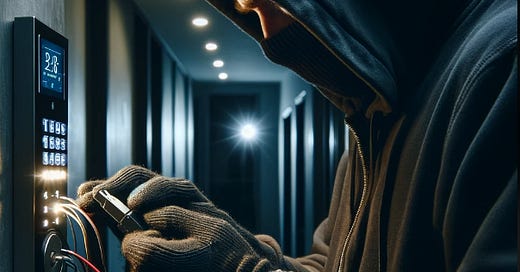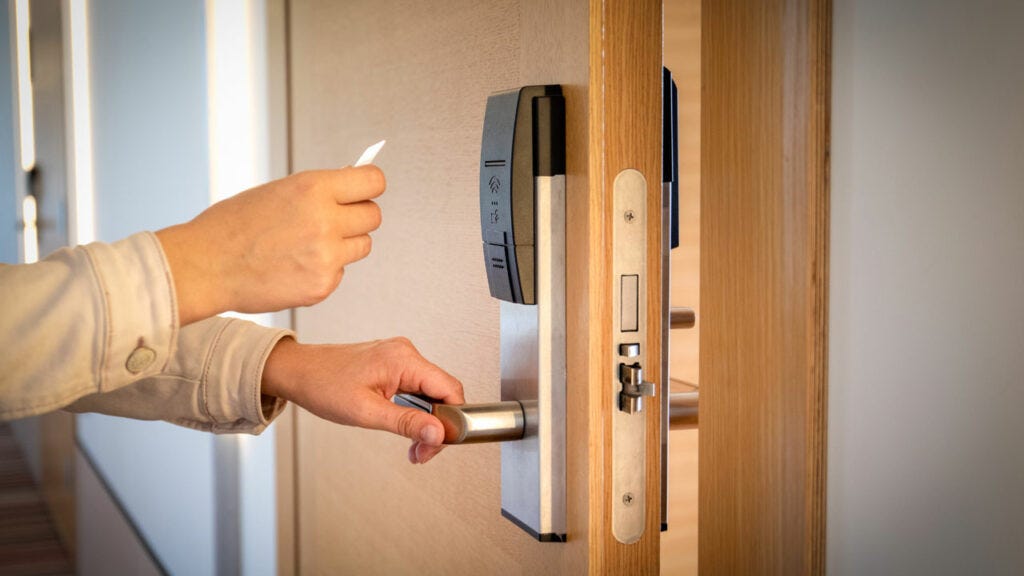Impact of electronic hacking devices on school security
Handheld devices advertised on social media can read, copy, and transmit digital access codes to open almost any electronic keycard lock.
With billions of tax dollars being spent on school security, many campuses are installing electronic door locks. The perceived advantage is that every door in the school can instantly be secured during an emergency. At the same time, police officers with keycards will be able to easily get into the building. There’s one problem with these electronic locks that school officials may have overlooked: There is a $170 device sold online that can open them.
Have you noticed ads on social media platforms like Facebook and Instagram for a device that allows you to hack electronic access readers? If not, there is a good chance that your teenage kids or students will have seen it.
This handheld device can scan nearby electronic keycards and copy their data. The device can also rapidly transmit a series of possible access codes to hack an electronic reader.
Like many other loopholes, this device can be legally sold and shipped in the US. It’s not illegal to sell, it’s just illegal to use it to hack security systems and electronic readers.
Homeland Security officials and police are worried enough about these devices that an intelligence bulletin was sent about the risks of terrorists using them to access critical infrastructure facilities.
Just like at telecom or power substations, these devices create a whole bunch of problems for school security. Think about how many different electronic locks on a school campus could be hacked.
Can a school with electronic doors be secured against a school shooter who can easily open them?
Electronic Door Locks
Many schools have electronic door locks on the exterior and interior doors of a school that are opened with a cellphone app, card, or key fob. This is an easy way for multiple staff members to be able to open a door without everyone needing a physical key. Electronic locks can also have different permission settings based on time/date so that students can open a door during school hours but can’t get into the building late at night.
With a hacking device, someone plotting a school shooting could access the campus during nights or weekends to stage weapons and explosives. An attacker could also enter the school through an electronically locked backdoor while staff are focused on students being screened for entry at the front door.
If the campus goes on lockdown and the classrooms have electronic locks, an attacker with this hacking device can get into the locked classrooms too.
SRO’s Office
A primary focus of school security is keeping weapons out of the school building with scanners, video analytics systems, metal detectors, and bag searches. At the same time, some schools also have a cache of weapons inside the building for the SRO or trained staff to access during a school shooting.
If the weapons are stored in the SRO’s office, there may be an electronic card reader on the door so that multiple staff members or the first arriving police officers can quickly get inside.
Rather than sneaking guns into the school, if an attacker can hack the electronic door lock and access the weapon cache, these guns will be accessible. In addition to weapons, there may also be police radios, body armor, helmets, and ballistic shields that can protect the attacker against arriving patrol officers.
If the office has video screens showing the CCTV cameras, the attacker will be able to see where students are hiding and where police are entering the building. With access to a police radio, the school shooter can monitor the police response and make erroneous reports to confuse responding officers.
Electronic Gun Safes
Some school districts allow staff members to be armed and have weapons staged in locked gun safes around the school (example: Utah and Indiana). Instead of staff members needing to fumble with keys during an emergency, there is a good chance that some of these gun safes have electronic access.
If a teenager is plotting a school shooting, the hardest part of the plan may be obtaining guns when they are too young to legally purchase them. If a student can hack an electronic lock to get a gun stored in an empty classroom or common area, this makes the school shooting plot much easier to carryout.
Parents may also store guns at home inside electronic safes. A student being malicious rather than maniacal could also open an electronic safe—inside the school or at home—to show off to friends or take the gun out to play with. Firearms accidents and suicides involving children and teens are more common than planned attacks at schools.
Panic Buttons
The hacking device works on more than just electronic locks. If a school has wireless panic buttons, these can be hacked to set off the alarm.
Any remotely controlled or wireless device including lights, projectors, window shades, automatic door closers, vehicle gates and garage doors, HVAC, public address systems, and some fire alarm systems may be vulnerable.
Admin Office, Storage, and Utility Rooms
Part of a recently averted school shooting plot involved disabling the CCTV system and releasing anesthetic gases into the school. While this was a plot that wasn’t feasible, there are lots of things that can go wrong if an attacker can sneak into any room that has an electronic lock.
If a student planning to carry out an attack hacks the lock to the utility room, they could disable power and IT systems that are needed to send emergency notifications. Utility rooms or storage areas could also be locations where explosives or toxic chemicals are staged and detonated/released.
What’s Next?
Aside from school shooting plots, there is a whole lot of mayhem and mischief that students can carry out with access to every part of the school building and control of any wireless device inside it.
School officials need to keep track of innovative and disruptive products that impact school security systems. Luckily, you can subscribe and share these articles, and I’ll do my best to keep track of these trends for you.
If I was a school official or SRO, I would buy one of these devices to see how it works and how it impacts the security systems on campus. On a campus that has guns and police equipment stored inside a room or safe with an electronic lock, I would suggest reassessing if that equipment is secure.
Do you have other questions about school security products, planning, and procedures? If so, email me at k12ssdb@gmail.com and I’ll answer them in a future article.
David Riedman is the creator of the K-12 School Shooting Database and a national expert on school shootings. Listen to my recent interviews on Freakonomics Radio, New England Journal of Medicine, and Iowa Public Radio the day after the Perry High shooting.








